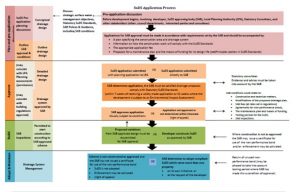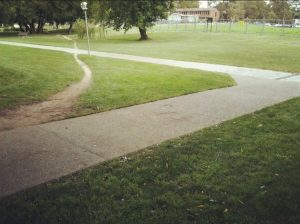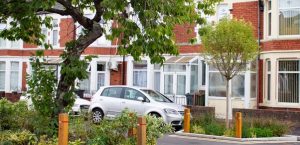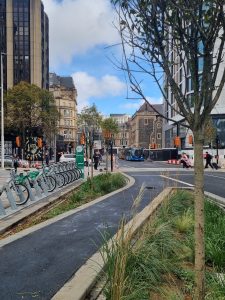Back in January the Government announced Sustainable Drainage Systems (SuDS) will become mandatory on all new developments in England through the implementation of Schedule 3, with the new approach expected sometime in 2024. As a result, over the past few weeks here at Rennard Consulting we have been taking a closer look at Schedule 3, how it came to be and what it could mean for architects and developers on their future projects.
It may come as a surprise, however, that while the implementation of Schedule 3 is a fairly new concept in England, it has actually been operating in Wales for some time. This therefore got me wondering… are there were lessons we take away from our Welsh drainage colleagues?
To try and answer this question I was lucky enough to be able to catch up with the fabulous Ian Titherington, former SAB at Cardiff Council and now a Senior Advisor on Sustainable Drainage to the Welsh Government to pick his brains on all things SuDS and Schedule 3.
Below is a summary of what we discussed.
So, let’s start with some basics, when was Schedule 3 implemented in Wales and what does it look like?
Schedule 3 came into effect in Wales on the 7th January 2019, a day Ian says with a smile was when his life changed forever. In essence, Ian states it’s a way of ensuring that surface water is considered first and not last when setting out a site and focuses on the following six key principles:
- Runoff destination
- Hydraulic control
- Water quality
- Amenity
- Biodiversity
- Construction, operation, and maintenance.
As part of any application, under Schedule 3, it will need to be demonstrated that the design meets the above six principles to gain SAB approval with SAB, or SuDS Approving Body, being established to:
- Evaluate and approve drainage applications for new developments where construction work has drainage implications, and
- Adopt and maintain SuDS schemes, subject to the conditions and exemptions specified in the 2010 Act.
Is SAB approval the same as planning?
No, SAB approval is completely separate from planning and while collaboration with all approving bodies is critical, Ian recommended that engagement with the SAB officer should happen prior to any planning application as generally SAB approval is onerous.
The application process itself consists of an application form (which can be found on Welsh Government Website) and supporting documentation. Ian noted that currently Wales was hoping to roll out a light version of the document aimed to make the process simpler for smaller developers, so this is certainly something to keep an eye out for.
In addition, while not compulsory, Ian recommends early discussions with SAB’s are crucial to a smoother approval project process and ensuring projects get off to the right start.
Figure 1, take from the Welsh Government Sustainable Drainage (SuDS) Statutory Guidance provides a great summary of the current process for getting SAB approval with a link to the full document listed below.
Figure 1: Flow chart of SuDS Application process

Source: Sustainable Drainage (SuDS) Statutory Guidance
So, what lessons learnt should England be taking from the implementation of Schedule 3 in Wales?
While not without its challenges, Ian was clear that the implementation of Schedule 3 in Wales has been a positive thing, both from a climate change perspective and from ensuring the successful implementation of SuDS across developments.
With England now following in their footsteps, I was keen to find out of there were any lessons learnt or anything we should be aware of as designers as we gear up for this change in legislation.
From a design perspective, while it may seem obvious, Ian said that it is so important to carry out site visits and that when reviewing designs, he was a regular ‘puddle hunter’. In essence, this means getting out and about when it rains to get a visual understanding of how water currently interacts with a site, where those boggy bits are and start to build up a picture of the runoff profile. No matter which part of the project you are involved with, Ian explained that site visits can unlock vital pieces of information which are just not visible from a desk top study.
Another key lesson learnt, which we have already touched on slightly is the importance of early engagement with your SAB officer. Now on the face of it, it can be tempting to just get started on a project, however, Ian says that SAB officers are as keen as you are for your projects to be successful and as such a quick chat with them early to discuss the key design principles, where your discharge point will be and to get confirmation as to what you will need to submit can ensure the whole process runs smoothly and prevents both abortive cost and time. Also don’t forget to consult with your SAB officer before gaining planning approval!!
Ian also highlighted the importance of allowing sufficient time and budget for supervision and support of the contractors appointed to install any SuDS feature. While SuDS are not a knew thing, many contractors are still getting to grips with the in’s and out of their construction and also the impact site operations can have on their performance. One example Ian gave was an installation of a infiltration basin on a housing estate. On completion and following the first significant rainfall event the site experienced flooding when the infiltration basin didn’t drain as expected. On investigation, it was found that the site compound had been positioned on the site of the infiltration basin, thus, compacting the earth and significantly changing the infiltration rate. Ian highlighted that a bit of collaboration and supervision between the design and contractor to ensure that the design was fully understood and the potential implication of a site operations could have resulted in a completely different outcome.
Finally, Ian concluded with stating never underestimate human nature and the importance of designing with people in mind. This could range from thinking about how likely it is for a system to be maintained and the subsequent impact poor maintenance could have on a design, to thinking about how the general public are going to interact with a site, i.e. are they likely to take a short cut through your SuDS feature, how should the design change to accommodate this?
Figure 2: Example of how human nature can be different to design intent

Ian’s top three tips for developers!
So, what are Ian’s top three tips for developers submitting a design under Schedule 3?
- Talk early to SAB and Planning – it is important to understand what your SAB and planning officer are looking for, what concerns they might have that you need to mitigate and find out what information they will want to see as part of your submission.
- Don’t set your layout in stone until you have spoken to your SAB – There may be site constraints with relation to the drainage that need to be considered. Your SAB, in combination with your drainage engineer will be able to help you identify these early and develop a strategy that takes them into account. If you therefore spend considerable time developing layouts before these discussions have taken place you run the risk that there could need to be an element of redesign which could add time to your programme as well as additional cost.
- Design with the flow of water in mind – Water will always flow from the highest point of your site to your lowest on the path of least resistance. As such if you put your building within one of these flow paths, or at the point where your attenuation needs to go, you could be creating a costly problem to solve. In addition, where possible, try to keep drainage at the surface for as long as possible, as this decreases your cost and maintenance requires and keeps options open for as long as possible.
Schedule 3 Success stories
To wrap up I asked Ian to pick some of his favourite SuDS success stories to give a feel for what can be achieved when the design process is done well.
These were Ian’s top picks.
Greener Grangetown
Greener Grangetown is a fabulous SuDS project located close to Cardiff city centre on the western side of the River Taff. Delivered in partnership with Cardiff Council, Welsh Water and Natural Resources Wale, designed by Arup and constructed by ERH Communications and Civil Engineering it uses retrofitted SuDS across 12 Victorian Streets to remove approximately 4.4ha of surface water from the combined sewer network.
Figure 3: Greener Grangetown

Source: https://greenblue.com/gb/case-studies/greener-grangetown/
It was a great example of how community engagement is vital for a successful project and showcases how drainage doesn’t have to be simply buried pipes in the ground.
If you would like to know more, SuDSdrain have produced an amazing case study which can be found by following this link (https://www.susdrain.org/case-studies/pdfs/greener_grangetown_case_study_lightv2.pdf).
Central Square, Cardiff
Knights Brown were awarded the £6.4m Central Square project for Cardiff City Council in March 2020. The project involves highways improvement works in the Central Square development area in Cardiff City Centre.
The project uses a combination of rain gardens, tree cell systems, swales, and ponds to manage rainfall runoff. Apart from managing flooding, the drainage system has additional benefits like adding green cover and biodiversity, boosting wildlife in the city, managing street pollution and securing the general health and well-being of the people.
Figure 4: Raingardens on Wood Street

Source: Ian Titherington site photos
Summary
From my chat with Ian, while the implementation of Schedule 3 in Wales has had its challenges, generally, it has been seen as a positive and has helped to deliver some fantastic SuDS projects.
While there is still some uncertainty as to what it could look like in England, taking and building on the lessons learnt can enable us to be in a great position when it comes to designing resistance in our future developments, help us build a more sustainable future and unlock the hidden benefits good drainage design can bring.